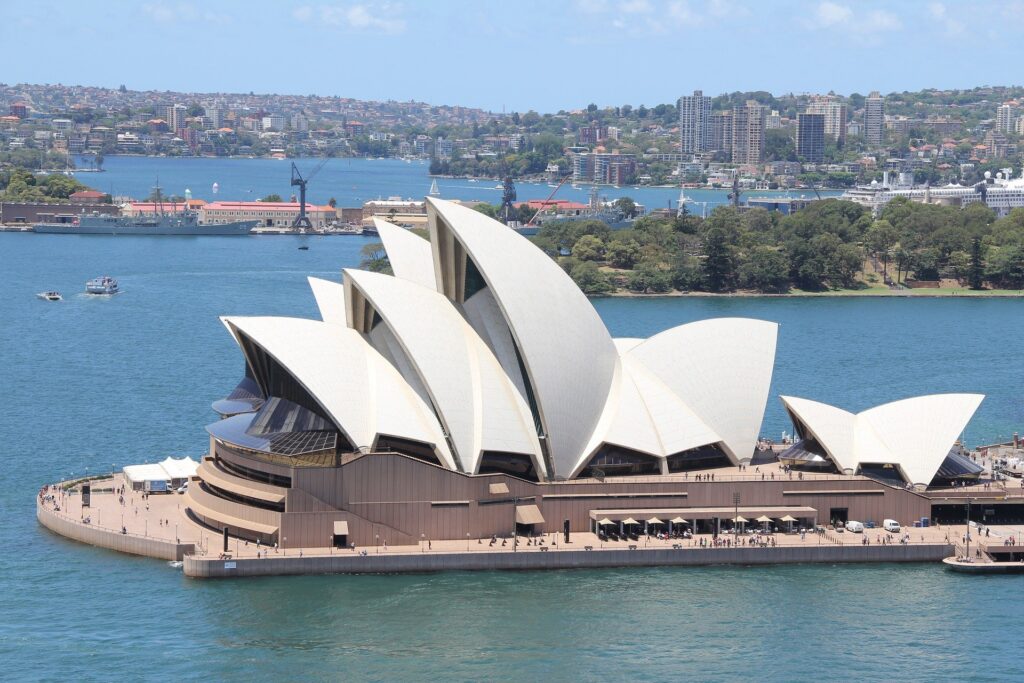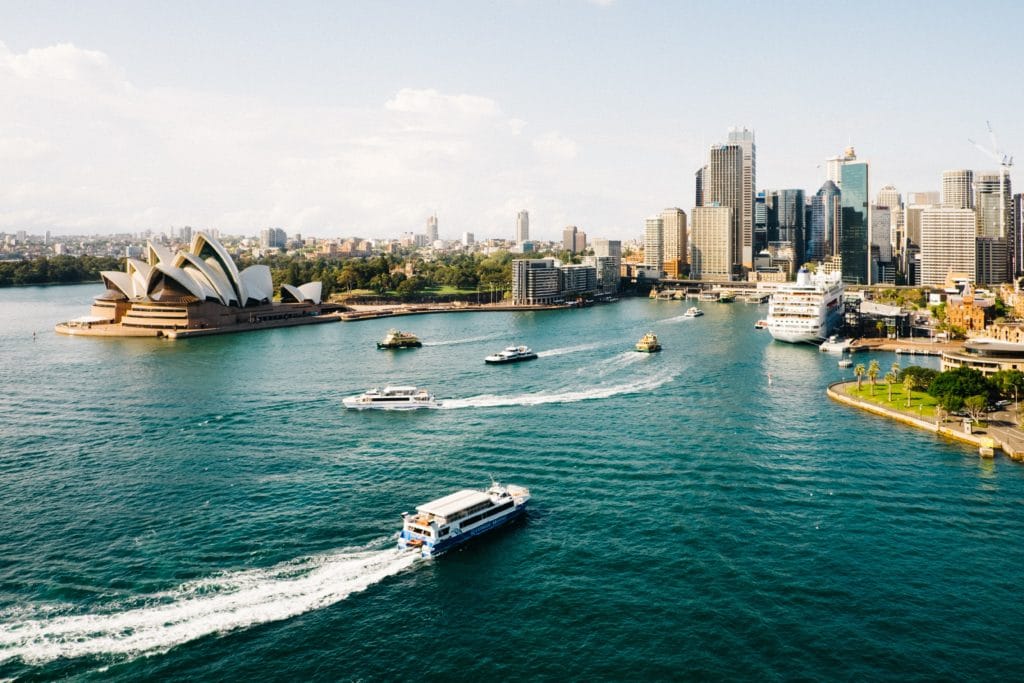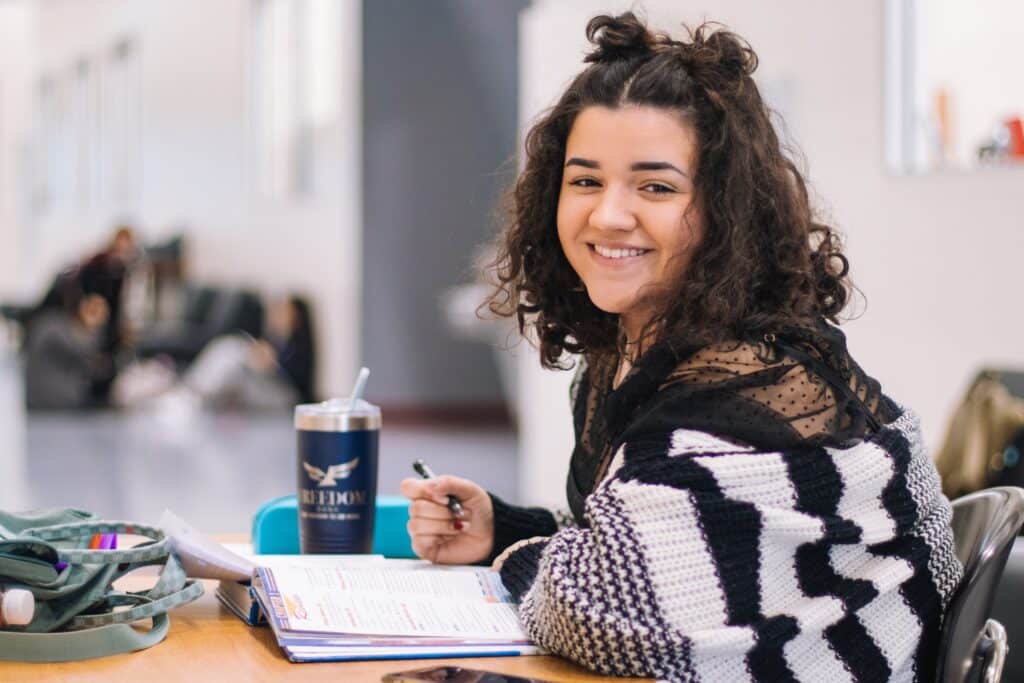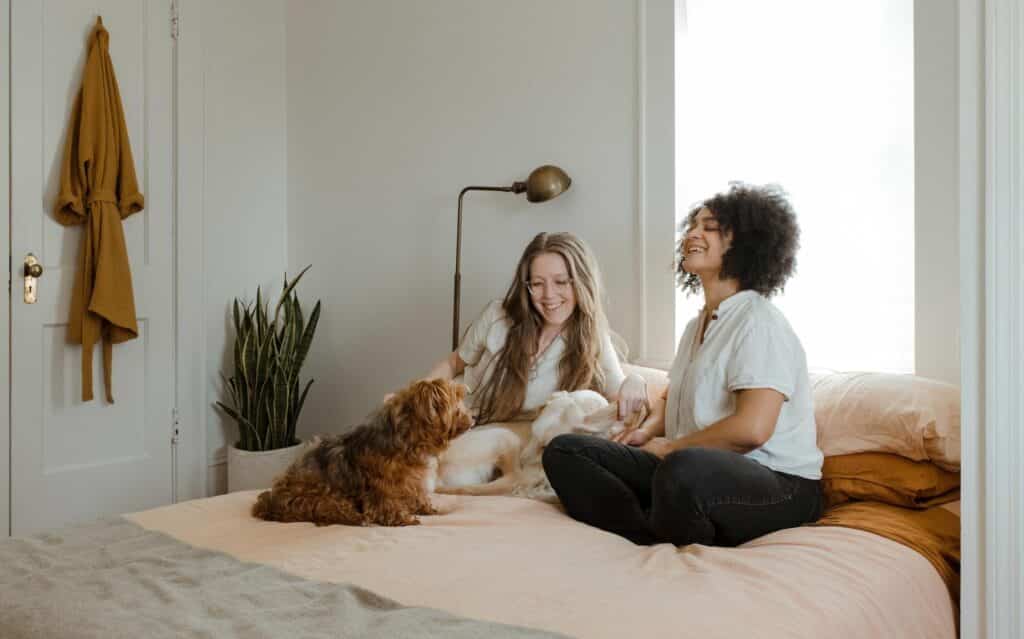Last updated on June 24th, 2023 at 11:04 pm

Here at Remitly, our customers move to Australia for a variety of reasons. Some relocate to find work or study abroad. Others receive jobs from Australian employers or choose to retire in the country.
Australia has a welcoming immigration policy, with 29.1% of the country’s population in 2021 being born overseas. Around 90,000 Americans lived in the country at that time, and a growing number of Canadians are also moving to Australia.
If you’re considering moving abroad to Australia, this guide will tell you what you need to know about the country. Read on to learn how to immigrate to Australia and to learn more about what living in Australia is like.
A brief overview of Australia
Australia is an island continent located in the southern hemisphere. The Indian Ocean lies to the west, and the Pacific Ocean is to the east. Nearby countries include New Zealand to the southeast and Indonesia and Papua New Guinea to the north.
Here are some key facts about the country.
- Size: 7,741,220 total sq km, making it slightly smaller than the 48 states of the continental U.S.
- Capital: Canberra
- Major cities: Sydney, Melbourne, Brisbane, Perth, Adelaide
- Population: 26,461,166 as of 2023
- Foreign-born population: 7.5 million as of 2021
- Official language: English
- Demographics: 33% English, 29.9% Australian, 9.5% Irish, 8.6% Scottish, 5.5% Chinese, 4.4% Italian, 4% German, 3.1% Indian, 2.9% Australian Aboriginal, 1.7% Greek, 4.7% unspecified
Australia is known for its diverse landscapes, with tropical beaches, rainforests, and deserts all located on the continent. People also know the country for its unique animals that only live in Australia, such as kangaroos and koala bears.
The country also has a wealth of national resources. It’s the world’s largest net exporter of coal and the biggest supplier of opals. Australia is also home to the largest uranium reserves on the planet.
Can a U.S. or Canadian citizen move to Australia?
Moving to Australia from the U.S. or Canada is possible, provided you meet certain requirements and go through the country’s immigration process. Continue reading to learn about the Australian immigration system.
What are the requirements to move to Australia?
Canadian and U.S. citizens do need a visa for Australia whether they’re coming to the country as a tourist or want to relocate there. The country has some set requirements for all visas, from Australian visitor visas to Australian work visas. They include:
- Meeting minimum health standards as established through an approved panel physician
- Having a clean criminal record. You may be asked to submit a police certificate to attest to this
- Holding a valid passport from your home country
- Paying the required fees, which vary by visa type
For some visas, you’ll also need to provide biometric data, including fingerprints and a photograph, for identification purposes.
An Australia tourist visa is only available for people who wish to vacation in Australia or travel to the country for business or medical treatment, and it doesn’t grant the right to work. As a result, it’s generally unsuitable for people moving to Australia from the USA or Canada.
Instead of a tourist visa, you’ll need to obtain one of the other Australian visas. They include:
- Australia family stream visas: For eligible New Zealand citizens, close relatives of Australian citizens, and permanent residents and people who need to relocate to Australia to care for a relative
- Australia workstream visas: For people hired by Australian employers who are willing to sponsor them and for those who have skills that are in demand in the country
- Australia business and investment stream visas: For individuals who make a significant investment in the country or are moving to Australia to open a business that will create jobs
- Australia retirement visas: For individuals who have steady retirement income
- Australia former resident visa: For former permanent residents who moved away from Australia and wish to return
- Australia global talent visas: For people who have achieved excellence in a profession, sport, the arts, or academia
- Australian humanitarian and refugee visas: For people who are leaving their home countries due to persecution or threats to their safety
Each type of visa has additional requirements. For example, you may need to show proof of employment from a sponsoring Australian business or prove that you are financially stable by submitting bank statements if you’re applying for one of the country’s work visas.
How do you get a visa to move to Australia?
The process for getting an Australian visa varies depending on the type you’re applying for. You can apply for some visas online through the ImmiAccount system.
For other visas, you’ll need to set up an in-person appointment at an Australian consulate or embassy. In the USA, there are locations in Chicago, Honolulu, Houston, Los Angeles, New York, San Francisco, and Washington, D.C. Australia also has offices in Ottawa, Toronto, and Vancouver.
Learn how to prepare for your Australia visa application.
Does Australia offer digital nomad visas?
As of May 2023, Australia doesn’t have a digital nomad visa program. A digital nomad visa allows a person to reside in one country while working remotely either as a self-employed individual or for a foreign employer. In some cases, you may be able to work remotely while in Australia on a tourist visa.
Can you live in Australia permanently?
Most of the Australian immigration streams outlined above grant visas that allow for permanent residency. You’ll typically be able to renew your visa if you obey all laws and submit the required application on time.
After living in Australia for at least four years on a valid visa, you may be eligible to become an Australian citizen if you meet character requirements, pass a citizenship test, and have a close and continuing link to Australia, such as a job, bank account, or history of paying taxes.
How much money do you need to move to Australia?
The cost to move to and live in Australia will depend on a number of factors, including where you choose to live and what standard of living you expect. Let’s dig into some of the costs associated with moving to Australia.

What is the cost of living in Australia?
Generally, the cost of living in Australia is higher than in the U.S. and Canada. One reason is that Australia’s island status makes it more expensive to ship items into the country.
As you weigh the pros and cons of moving to Australia from a financial perspective, keep in mind that prices down under still may be less than what you’re accustomed to paying, depending on where you live.
For example, it’s 16.7% less expensive to live in Sydney than it is to reside in New York City, and consumer prices are 1.7% more in Los Angeles than in Sydney. On the other hand, consumer goods cost 13.9% more in Sydney compared to Vancouver.
The cost of living also varies depending on which Australian city you move to. Here are the average monthly costs for renting a one-bedroom apartment in the city center of major Australian cities:
- Adelaide: A$2,150.76
- Melbourne: A$2,238.92
- Perth: A$2501.13
- Brisbane: A$2524.15
- Canberra: A$2,758.68
- Sydney: A$3,047.85
How much will you need to make each month to live in Australia?
In Australia, the median weekly salary as of August 2022 was A$1,250. This statistic means that half of the population earned less than that amount per week, and the other half earned more. The highest-earning 10% of the population made A$2,720 or more per week, and the lowest-earning 10% received A$800 per week or less.
You can use this information as a reference to determine how much you’ll need to live each month in the country. You’d need to earn around A$5,000 per month to earn the median salary.
Keep in mind that costs may be higher or lower depending on where you live. You’ll typically pay more for rent and purchases in Sydney and Canberra than in Adelaide or Melbourne.
How to set up a bank account in Australia
Many Australian banks will allow internationals to open an account online and fund it with an electronic deposit. However, you typically won’t be able to use the account until you arrive in Australia and visit a branch office to show proof of your identity, such as your passport and driving license.
Read our guide on how to open a bank account in Australia to learn more about the banking system and discover some popular financial institutions for members of Australian expat communities.
What type of government does Australia have?
As a former British colony, Australia has a parliamentary governmental system similar to the UK. The monarch of the UK is the head of state but plays only a ceremonial role in Australia.
The Prime Minister is the actual head of the government in the country. They are chosen by their political party or the coalition government to serve in the role and receive advice from the cabinet.
Australia’s parliament consists of a 76-seat Senate and a 150-seat House of Representatives. Senators get elected through voting for six-year terms, while elected Representatives are in office for three years.
The judicial courts interpret Australia’s laws. Australia’s constitution gives the prime minister power to appoint judges to the country’s high courts. Once appointed, they serve until the age of 70.
Like the U.S. and Canada, Australia comprises states with their own legislatures that create and pass laws. There are six states and two self-governing territories:
- Queensland
- New South Wales
- Tasmania
- Victoria
- South Australia
- Western Australia
- Northern Territory
- Australian Capital Territory
In Australia, all citizens of Australia aged 18 and older must enroll to vote in federal and state elections.
Is there a U.S. or Canadian embassy in Australia?
Both the U.S. and Canada have friendly diplomatic relationships with Australia. As a result, both countries have embassies and consulates down under. Locations of U.S. embassies and consulates include Canberra, Melbourne, Perth, and Sydney. Canada has consular offices in Canberra and Sydney.
What are the taxes like in Australia?
Australia has a tax-free threshold of $18,200 as of May 2023. You are responsible for paying income taxes by October 31 each year if you earn more than that. Depending on annual income, the tax rate is 19% to 45% for residents.
In some cases, the tax-free threshold may be adjusted for immigrants during their first year in Australia. A tax professional can help you determine how much you need to pay. Learn how to file taxes in Australia by reading our guide.
Many goods and services in Australia are subject to a goods and service tax (GST) of 10%. This amount is added to the total price that you pay. Some states also assess taxes called stamp duties on Australian real estate transactions and other major purchases.
Is Australia a good place for North American expats?
Many North American expats find that the pros and cons of living in Australia weigh heavily on the benefits side, as the country can be a great place for Canadian and U.S. citizens. The quality of life, overall safety, education, and healthcare systems will show you why.
What is the quality of life in Australia?
Overall, Australians enjoy a high quality of life. In 2023, the World Happiness Report ranked Australia the 12th happiest place to live, putting it ahead of Canada at 13 and the U.S. at 15.
Quality of life does vary in Australia. Around 13.4% of Australians earn enough to be below the poverty line, and the country ranks 15th highest among OECD countries for its poverty rate. It’s important to note that the U.S. ranks 10th on the same list.
Generally, most expats will enjoy a high standard of living in Australia.
How safe is it to live in Australia?
Many parts of Australia are very safe to live in. The country generally has less crime than the U.S. but slightly more than Canada.
Crime rates vary throughout Australia. Alice Springs, Rockhampton, Cairns, and Darwin have more crime than the major cities of Sydney, Melbourne, Perth, Brisbane, and Adelaide. Of all the major cities in Australia, Canberra is generally the safest.
Because Australia is generally a safe place, the U.S. State Department advises Americans to just exercise normal precautions while in the country. Some things that you can do to stay safe include:
- Be aware of your surroundings
- Avoid walking alone at night
- Stick to well-lit areas where other people are present
- Be careful not to display large amounts of money
- Keep a close eye on your possessions when in crowded places
What is the education system like in Australia?
The education system in Australia is similar to those in the U.S. and the UK in that it emphasizes hands-on learning. However, it has its own structure divided into four tiers:
- Primary school: Begins at age 6 and lasts for 7 or 8 years
- Secondary school: Runs for 3 or 4 years
- Senior secondary school: Runs for 2 years
- Tertiary education: Vocational training and college
All children between the ages of 6 and 13 must attend school in Australia. There are three main school systems for primary, secondary, and senior secondary school:
- Public school: Public schools are free for all residents of Australia to attend. However, families may be asked to make donations to the school or to pay for things like field trips and social events.
- Catholic schools: These schools are open to people of all faiths but do include religious instructions in addition to the regular curriculum. Catholic schools charge tuition, but some do have scholarships available.
- Independent schools: These private schools include other faith-based and non-faith-based institutions. Students typically pay tuition to attend, but there are sometimes scholarships available.
There are more than 1,100 tertiary educational institutions in Australia, and many of them rank highly on listings put together by publications like QS World, Times Higher Education, and U.S. News and World Report.

Some top colleges and universities in Australia include:
- Australian National University in Canberra
- Curtin University in Bentley
- Monash University in Clayton
- University of Adelaide in Adelaide
- University of Melbourne in Melbourne
- University of New South Wales Sydney in Kensington
- University of Queensland in Brisbane
- University of Sydney in Sydney
- University of Technology Sydney in Ultimo
- University of Western Australia in Crawley
What is the healthcare system like in Australia?
In 2021, the Commonwealth Fund Healthcare Report ranked the Australian healthcare system the third-best among high-income OECD countries. The country has both a public and private healthcare system.
All Australian and New Zealand citizens and immigrants who have or are applying for permanent residency can access the public healthcare system known as Medicare. It covers the cost of many health expenses, such as:
- General practitioner visits
- Specialist visits
- Hospital care
- Diagnostic tests
- Most surgical procedures
- Eye tests conducted by optometrists
- Some dentistry services
To get care through the public healthcare system, you’ll need to enroll in Medicare by completing a form and submitting it by mail or email. Once your application gets approved, you’ll receive a Medicare card to present when you receive healthcare.
Although the public healthcare system delivers high-quality care, some citizens and permanent residents choose to use the private healthcare system. Private hospitals and clinics usually have shorter wait times for routine appointments and medical procedures, and private Australian health insurance may pay for some services that Medicare doesn’t.
Learn more about how to get health insurance in Australia by checking out our guide.
What is the climate/weather like in Australia?
As you may expect given the size of Australia, weather varies across the country. Its position in the southern hemisphere means that summer occurs during the months of December, January, and February, and winter is in June, July, and August.
Here’s a look at the typical minimum and maximum temperatures for some of Australia’s major cities:
- Adelaide: 62 to 83°F (16.5 to 28.5°C) in January and 49 to 59°F in July (7.5 to 14.9°C)
- Brisbane: 70 to 84°F (20.9 to 29.1°C) in January and 49 to 69°F (9.5 to 20.6°C) in July
- Canberra: 56 to 82°F (13.2 to 28°C) in January and 32 to 53°F (0.1 to 11.4°C) in July
- Melbourne: 58 to 79°F (14.3 to 25.9°C) in January and 43 to 56°F (6 to 13.4°C) in July
- Perth: 62 to 89°F (16.9 to 31.6°C) in January and 46 to 64°F (8 to 17.9°C) in July
- Sydney: 66 to 80°F (18.8 to 26.4°C) in January and 45°F to 63°F (7.1 to 17°C) in July
Severe thunderstorms and cyclones do occur in Australia and are most common from September to March.
Is it easy for Americans and Canadians to find a job in Australia?
In April 2023, unemployment in Australia was 3.6%. This rate is rather low and indicates that the job market is strong across the country. However, how easy it is for Americans and Canadians to find work in Australia will depend on where they choose to live and their skills and education.
Some of the most in-demand jobs in Australia include:
- Construction managers
- Civil engineers
- Early childhood educators
- Registered nurses
- Information systems analysts
- Software and applications programmers
- Electricians
- Chefs
- Childcare workers
- Aged and disabled care workers
Exploring your new home: Things to do in Australia
Whether you enjoy outdoor activities, hitting the beach, or cultural attractions, there is plenty to see and do in Australia. Some of the popular attractions include:
- Adelaide: Adelaide Central Market, Adelaide Botanic Garden, Art Gallery of South Australia
- Brisbane: South Bank Parklands, Lone Pine Koala Sanctuary, taking a river cruise on a CityCat boat
- Canberra: Australian War Memorial, Australian Parliament House, National Zoo and Aquarium
- Melbourne: Royal Botanic Gardens, The Circle Tram, National Gallery of Victoria
- Perth: Kings Park and Botanic Gardens, The Perth Mint, The Bell Tower
5 things to know about the culture in Australia
Researching the local culture is an essential part of the process of how to move to Australia from the USA or Canada. To get you started, here are some important things to know about Australian culture.
1. Equality is a key value
Australians have a philosophy of “fair go,” meaning that they believe that everyone deserves equal opportunities. They value equal rights for all genders, races, abilities, and sexual orientations.
2. The oldest surviving civilization on Earth lives in Australia
Australia’s First Peoples have resided on the continent for at least 65,000 years, making them the oldest surviving civilization on Earth.
Around 43.8% of Aboriginal and Torres Strait Islanders live in regional areas, while 34.8% reside in major cities. The remaining 21.4% make their homes in remote areas of Australia.
3. Australians speak their own form of English
Even if English is your native language, you may have difficulty understanding some Australians when you first arrive. Aussies have their own slang and abbreviate many words. Check out Charles Sturt University’s guide to Aussie slang to learn more.
4. Drinking is a part of the culture
Australians consume a lot of alcohol. In fact, more than 10,000 kinds of spirits, beer, and wine are sold in the country, and the World Health Organization ranks the country third in terms of alcohol consumption per capita.
5. Many Aussies are sports fans
Many Australians love sports, and the country is home to major international events like the Formula One Grand Prix and the Australian Open.
Professional sports leagues in Australia include the Australian Football League (AFL) and the National Rugby League (NRL), and it’s common to hear people discussing the scores from recent matches.
Cricket is considered by many to be the national sport of Australia. There are recreational leagues throughout the country, all overseen by Cricket Australia.
What are the best places to live in Australia?

Deciding where to live in Australia is an important step in the process of how to move to the country. In some cases, where you choose to live may be determined by your job or the location of your family. If you have the freedom to settle anywhere, read on to discover some of the best places for retirees, families, and young singles to consider.
For retirees
Seniors who want to live near the beach may love Mornington Peninsula, Victoria. Dotted by coastal villages, the area is home to golf courses, national parks, and many local markets. Melbourne is only 1.5 hours away by car to access high-quality hospitals and cultural events.
St. Helens in Tasmania is another good option, especially for seniors who want to live somewhere quiet without sacrificing access to a local hospital, supermarkets, bars, and restaurants. This town in South Australia has it all, and the cost of living is very low.
For families
Only 35 to 45 minutes away from Sydney via train, Wahroonga, New South Wales, is popular for families. Many highly-rated private schools are in the area, including some Catholic schools and special schools for children with disabilities. One downside is that Australian expat real estate prices tend to be high because many people want to live in the area.
Families can consider the twin cities of Albury, New South Wales, and Wodonga, Victoria, for a more affordable option. The Murray River separates them, and on either side, you’ll find affordable housing, good schools, and hospitals and clinics with excellent reputations.
For young singles
Melbourne and Sydney are two great places for young singles to move to. Their size means there are generally many employment opportunities, and both cities have thriving nightlife scenes. Young adults who want to return to school can also pick from several colleges and universities in Australia’s two biggest cities.
Single people who prefer to live outside of major cities can consider Byron Bay, New South Wales. This surf town is known for its cool hippie culture and PM party scene.
How to find a place to live in Australia
Housing options in Australia include renting and purchasing property. Since many North American expats have yet to establish credit in the country, renting is what many choose to do when they first arrive.
Check out our guide to renting a property in Australia to learn more about finding long-term Australian rentals for expats and what you can expect from the rental application process.
Now that you know about immigration to Australia and what it’s like to live in the country, you can continue your research and prepare to join the growing community of Australian expats who have relocated from the U.S. and Canada.
While you prepare for your move, download the Remitly app, so you can easily send money back home and learn about other handy apps for those moving to Australia.
